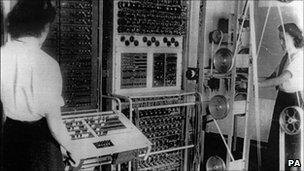A walk of fame for George the robot
- Published
Former spy catcher and RAF officer Tony Sale built a robot that steered itself towards a beer bottle in 1950.
One of the UK's earliest humanoid robots has been unearthed after spending 45 years stored in a garage. The robot's creator, Tony Sale, talks about how George came about.
Rationing during and after World War II gave rise to the make do and mend ethos that saw many people exercise their ingenuity to feed and clothe themselves.
Some, such as Tony Sale, took the scavenging attitude far beyond simply unravelling woollen socks to help patch a pullover.
In 1950 Mr Sale, then aged 19, created a robot named George out of scrap metal that came from a crashed Wellington bomber.
Pilot Officer Sale, as he was then, was stationed at RAF Debden where he was employed to teach pilots how to use radar.
"At RAF Debden officers were encouraged to build demonstration kit," he said, and George just about met that requirement even though he admits that there was no "specific order" to produce him.
Remarkably, George was not the first robot that Mr Sale had built. In fact, he was the fifth incarnation of a mechanical man that the young electronics wizard had put together.
Creating any kind of working robot in the early 1950s was an incredible feat, especially as Mr Sale was under 20 at the time. The version he produced then has a claim to be among the earliest humanoid robots built in the UK.
Mr Sale's prowess with a spanner and soldering iron remained undimmed.
He was the driving force behind the rebuild of the famous Colossus computer and one of the founders of The National Museum of Computing at Bletchley Park, as well as being a British spy-catcher.
Early days
"It started with my early attempts to build all sorts of things with Meccano," he told BBC News. "By the time I was 12 I had collected enough to build a small working robot that was in the Meccano manual."
The small robot detailed in the Meccano manual was capable of walking at a steady, if stately, pace by shuffling, rather than lifting, its feet.
In 1945, Mr Sale was studying at Dulwich College which, he relates with glee, was generously supplied with radio and electrical equipment.
More than enough to build another George the robot - this one was larger and controlled via radio. The innards of the robot were made from the ever-reliable Meccano but it had a skin made from cardboard.
The robot was such a marvel that it made an appearance on TV during which, Mr Sale, said the powerful radio transmitter used to control it wrought merry hell with the broadcasting equipment.
The next George dates from his early days at Debden. This version was pretty much man-sized and improvements to the basic unit also included a moving jaw to simulate speech.
The model of George, the Mark V, that survived to the present day was started soon after the end of WWII and Mr Sale's restless inventive mind added even more refinements.
"He was enhanced by having light sensitive cells in his eyes enabling him to home in on an illuminated beer bottle," said Mr Sale.
Garage Sale

Tony Sale led the project to rebuild the iconic Colossus computer
The steadily improving George caught the attention of the media and the robot, complete with Pilot Officer Sale operating him, were the subject of a Pathe news reel report.
Despite the publicity it was at this point that development of George pretty much ended. The mechanics and electronics of the robot were solid, said Mr Sale, but the computers of the time were too crude and too big to give him anything like a rudimentary intelligence.
"He went in to my garage and stayed there for 45 years," said Mr Sale.
It was there he stayed until Mr Sale got a call from researchers putting together the BBC TV programme Wallace and Gromit's World of Invention.
At their prompting, Mr Sale dug George out to see what condition he was in,
"It was still standing in the garage," he said. "I had a fair degree of confidence that he would work again."
"I put some oil on the bearings, added a couple of new lithium batteries, switched him on and away he went," said Mr Sale.
Wallace and Gromit's World of Invention is on BBC One at 7.30pm on 17 November.